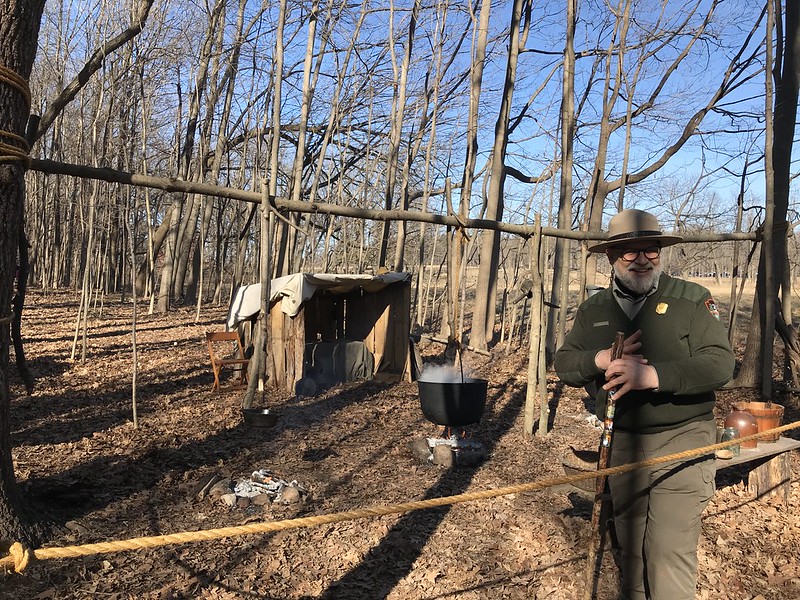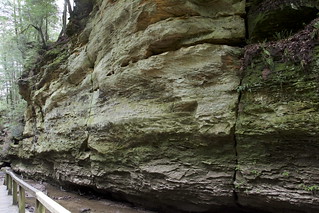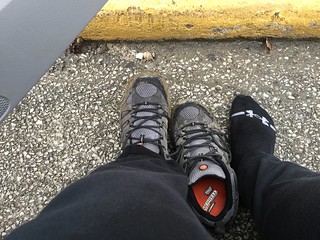Tag Archives: Indiana
Ridge and swale topography at Miller Woods, Indiana Dunes National Park
Miller Woods is part of Indiana Dunes National Park. The Wolverine, Amtrak’s train from Chicago to Pontiac (and back), passes it and offers an opportunity to see ridge and swale topography.
Deep River Grinders vs. Chicago Salmon (VBBA)
May 16, 2021
When J and I first visited Deep River County Park a few years ago, this sign intrigued us. We’d meant to return for a game, then along came COVID-19.
At last, however, with Pfizer shots 1 and 2 in arm and appropriate passage of time, we headed over to Indiana to see the Deep River Grinders take on the Chicago Salmon in a VBBA match.
We arrived just as the game was starting, and the good-sized parking lot was beyond full. Just as we were about to give up and park at one of the other lots a good walk away, a miracle happened — someone backed out of one of the prime spots close to the field. It was meant to be.
I plopped my chair on the near side of the field — the Grinders’ side. No matter — this is supposed to be a gentlemanly sport where everyone cheers everyone, everyone’s a good sport, and breaking the rules (including spitting) earns you a fine of 25¢, paid to the game’s judge.
While J went to a nearby table with food warmers that looked like it might belong to the hot dog vendor, a woman in period costume passed out cookies. Some, not all, were giving her donations, so I did too. I have no idea what they were for.
Meanwhile, it turned out the people with the food warmers were holding a birthday party, but they told J he could have any leftovers, which we did later in the game. Eventually we spotted the hot dog truck, so we ended up with two sets of hot dogs. And a cookie. And the popcorn I’d brought.
Early on the Salmon took the lead, although the Grinders started to come back. Then the Salmon had a blowout inning from which the Grinders couldn’t recover. As the game progressed, the judge (not umpire), sporting the town dress of a man of business, kept an eye on things (no doubt hoping to earn a 25¢ fine or two). He was drinking from what I thought was a beer bottle, which seemed out of place, but it turns out you can wash your hot dog down with sarsaparilla. I figured that out too late to get one.
For the seventh inning stretch, the teams performed a musical number from which we found out tidbits of trivia about many of the players.
Several times during the game, an alert sound popped up on someone’s phone. I was puzzled as the weather looked stable. I overheard that they weren’t weather alerts, but, sadly, Amber Alerts. At some point she turned the volume down, they stopped, or she left.
The game had started at 2 p.m. and ended before 4 p.m. There’s not much time wasted between pitches, batters, or innings.
After the game, some players stayed behind to practice with any interested children. One girl who looked to be about three or four years old hit the ball (with some help) and toddled around the bases (with some help). I wonder if she’ll remember that in 20 years. No doubt there’s video if she doesn’t.
Farewell to Interstate Inn, Gary, Indiana
While returning from Indiana Dunes today, I looked for the Interstate Inn off the I-90 on ramp. A quick glimpse left me with the impression it was gone. I was not wrong. It was demolished in June.

September 16, 2018

March 10, 2019
There’s some background about the inn at Lost Indiana.
Added July 12, 2020: The sign remains, much worse for the wear of the past two years.

Turkey Run State Park (and Shades)

April 19–21, 2016
Four years later, I realized I never wrote about a quick spring visit to Turkey Run State Park in Indiana. Luckily for anyone who finds this, I don’t remember much detail.
What I do remember:
- There were warning signs everywhere about “drownings have occurred.” Sure, but that wouldn’t happen to me, am I right? The first sign was on the sandy bank of a tranquil stretch of river. I was not fooled.
- Parts of Turkey Run State Park look like Starved Rock State Park, but instead of St. Peter sandstone, it’s Mansfield sandstone.
- Not far from the Lieber Cabin, I found many amazing rock formations, including some that tilted, some that were glassy smooth, and some that glowed under the overcast sky (not that kind of glow). I don’t get out much and had never seen anything like them.
- In this same area, we heard barred owls calling (“Who cooks for you? Who cooks for you all?”) The folks at the Nature Center seemed happy to hear this.
- We found out there’s a Turkey Run Inn. We may have eaten there. I can’t remember, but there’s evidence I raided the gift shop.
- I think someone mentioned there are several covered bridges in the area, so we visited as many as we could. Most are walk-through only. Billie Creek Bridge is the only one we drove across.
- Rocky Hollow–Falls Canyon Nature Preserve “contains deep sandstone canyons.” I wish there’d been time and energy to go farther (I always say that). This area most resembled Starved Rock.
- Rocky Hollow–Falls Canyon features Wedge Rock, which looks like a tilted flatiron. Glacial erratic? I wouldn’t want to stand under it for long.
Toward the end of the second day, we made a quick stop at Shades State Park but didn’t see much. Then we headed back down sunny country roads as the weather soon turned threatening.
Some but not all of the stops according to the Swarm app:
April 19
- Potbelly, Hyde Park
- Wolcott Rest Area Southbound, Wolcott, IN
- Kankakee Rest Area Southbound, DeMotte, IN
April 20
- Raccoon Lake
- Benjamin’s II, Rockville, IN
- Jailhouse Cafe, Rockville, IN
- Turkey Run State Park Inn, Marshall, IN
- Narrows Restaurant, Kingman, IN
April 21
- Benjamin’s II, Rockville, IN
- Jailhouse Cafe, Rockville, IN
- Shades State Park, Waveland, IN
- Wolcott Rest Area Northbound, Wolcott, IN
- City Office & Pub, Rensselaer, IN
- Hyde Park Animal Hospital, South Shore
Maple Sugar Time at Chellberg Farm, 3/7/2020
Last year’s Maple Sugar Time at Chellberg Farm was not productive. The daytime temperatures were too cold for maple sap to run. I remember someone saying they used water in the sugar shack — there wasn’t enough (or any?) sap for the demonstration. It was still fun and informative, even without the star attraction — maple sap.
This year’s a different story. Maple sap is pouring out of the sugar maples — literally. This extractor was filling every five to six minutes. At 2 p.m., the tub was about one-third full. By 4 p.m., it was nearly two-thirds full.
The warm air, sunshine, and freely flowing sap gave the day and everyone involved energy. We had our traditional Lions Club breakfast at 2, then checked out all the stations on the trail to the farmhouse.




After picking up some goodies (maple syrup, maple cream, maple water, and an Indiana Dunes National Park mug), we also visited Chellberg Farm’s current animal helpers, starting with Belgian team Bill and Jack.


After a stop at the Schoolhouse Shop and Tiger Lily’s for dinner, time to go home and rest my own sap.
Octave Chanute: Patron Saint of Flight
Facebook has many flaws, but it does alert me when events I might be interested in are coming up. A few weeks ago I found out about the world premiere of Octave Chanute: Patron Saint of Flight, at Indiana Dunes Visitor Center. I knew the Chanute name vaguely from the old Air Force base, but I couldn’t have told you then where the base had been located or why it was named Chanute. This sounded like a way to get in a visit to Indiana Dunes, learn something, and spend what might be otherwise a dull winter afternoon, depending on the weather.
The parking lot was unusually crowded, and when J and I walked in about a half hour early, a good-sized group was watching Shifting Sands: On the Path to Sustainability, a documentary on the history of Indiana Dunes and efforts to restore what can be restored. It’s meant to inspire, but it’s also tragic and depressing.
By the time Shifting Sands ended and Octave Chanute was scheduled to begin, the auditorium had filled up, even when extra folding chairs were brought out. Soon it was standing room only.
Simine Short, author of Locomotive to Aeromotive: Octave Chanute and the Transportation Revolution, and young director Paul Nelson introduced the film. I mention Nelson’s relative age because the audience was mostly 50 plus, possibly 60 plus, which disappointed me because I would like to see younger people interested in history. Of course, when I was younger none of my peers would have been interested, either.



Bridge 16, or the Portage Bridge
The presentation began with some technical glitches (flashbacks to every high school A/V club everywhere!), but my ears perked up at the mention of the Portage Bridge, accompanied by a photo I recognized immediately. Through this film, I found out Octave Chanute was the engineer behind the much-loved railroad bridge over the Genesee River at Letchworth State Park in New York.
Known for his bridges, Chanute was called in when the original timber trestle, the longest and tallest wooden bridge in the world when it opened in 1852, was reduced to ashes on May 6, 1875, after a train had passed over (spark?). Chanute’s iron replacement opened only 86 days after the fire. According to Short’s book, the piers were rebuilt and the uprights and girders strengthened in 1880, “making the bridge better than new.”

The original timber Bridge 16 over the Genesee River


Although modern Norfolk Southern trains were restricted to 10 miles per hour over the Letchworth gorge, Chanute’s bridge lasted until 2017, when the Genesee Arch Bridge opened. The state of New York declined the offer of the 1875 bridge, the last of which was demolished on March 20, 2018. I’d been fortunate to visit the old bridge one last time in 2015. When I’d found out about the premiere of this film, I’d had no idea it would take me back to perhaps the most iconic of my childhood memories. I remember walking along those tracks with my brother during one of his visits.
But wait! There’s more!
Kinzua Bridge
My ears perked up again at the mention of Kinzua Bridge. I’d found out about Kinzua Bridge State Park when I was looking up Kinzua Dam, another place I’d visited as a child, for my 2015 swing through Ohio, New York, and Pennsylvania.
It turns out that Octave Chanute was behind the original 2,000-foot-long Kinzua Bridge (or Viaduct), built in 1882 at 302 feet above the narrow valley floor. Short calls it Chanute’s “most spectacular bridge.” She adds that the bridge was rebuilt in 1900 “to keep up with the increasing volume and weight of the coal traffic.” Carl W. Buchholz redesigned the superstructure on the original masonry foundation piers.
By 1959 the viaduct failed safety inspections and was closed to commercial rail traffic. Restoration began in 2002, but in 2003 an F2 tornado “tore eleven towers from their concrete bases. Investigators found that the anchor bolts, installed under Chanute’s supervision, had rusted over the past 120 years.” Over time, the materials had failed the design.
After seeing this film, I’m even happier that I had the opportunity to walk out on what’s still standing of Kinzua Bridge and get a look at the remnants resting in peace on the valley floor. Even destroyed, Kinzua Bridge is indeed a “spectacular” sight.




Why Indiana Dunes?
Of course, most of the film was about Chanute’s contributions to flight and relationship with Wilbur Wright (rocky; Chanute was an open source kind of man and Wilbur believed in closely held information). What’s the link to Indiana Dunes? With their lake winds, elevations, and soft sand, the Dunes were Chanute’s choice for safely testing their experiments — the Kitty Hawk of the Midwest.
Epilogue, March 8, 2020
Octave Grill in Chesterton is named for Octave Chanute. Found out they serve a Chanute burger.

National Bird Day 2020
January 5, 2020, at Indiana Dunes State Park Nature Center
Remember the little bird who used to tell you things before anyone else did? One must have told J. that January 5, 2020, was National Bird Day, with a 10 a.m. activity at the Indiana Dunes State Park Nature Center.
Together with several families, we helped to fill the many feeders, logs, and hollow stumps behind the Nature Center with safflower, sunflower, and thistle seeds; peanuts; and other goodies. I was sure the presence of many people clomping around would deter the birds until we went back in, but several hung around in the trees overlooking the feeder area, and the bolder chickadees came in to see what was going on (or to make sure we were doing our jobs).
After breakfast at Third Coast Spice Cafe, a shopping interlude at Molly Bea’s, and a stop at the Indiana Dunes Visitor Center, we returned to take photos and for part 2 of National Bird Day — bird bingo. It didn’t take long to spot a cardinal, a titmouse, and a nuthatch eating upside down. The elusive square was held by the Cooper’s hawk. The staff told us they see one perhaps once a week. That no doubt puts a damper on the feeder activity.
After taking more photos, we settled into the very good little library at the nature center, which has books for kids and books on animals, nature, local history, and art. It’s a gem of a resource which I don’t often see in use.
After I spent more than I should (as usual) at the Schoolhouse Shop, we ended National Bird Day with half-price veggie pizza at Villa Nova in Chesterton. Mmmm. No chicken.
Downy and hairy woodpeckers
December 8, 2019, at Indiana Dunes State Park Nature Center
I’m a little slow but one day years ago when I saw a woodpecker at Promontory Point I realized there are two in the field guides that look very similar — the downy and the hairy. One is smaller but I could never remember which.
Smaller isn’t a good field sign if you haven’t seen both and you’re not sure of the relative proportions.
On a July 2018 visit to Indiana Dunes State Park Nature Center, two woodpeckers happened to land on opposite sides of the same feeder, facing each other. In that moment, I couldn’t miss the most obvious differences between the two, despite the similarity (mostly) of their plumage.
The downy is quite diminutive when seen across from his larger cousin, the hairy. More than that, the downy sports a delicate stub of a bill compared to the hairy’s railroad spike — the bill is almost the length of the hairy’s head.
Finally I got it. I will not have trouble identifying either again. There are other differences, but that bill is the most obvious. Now I have in mind: “downy=diminutive” — body size and bill.
As a side note, the downy is the one you’re more likely to see at your typical suburban bird feeder. I can’t be sure at this late date, but the downy is likely the one my dad fed with free suet from the local butcher.

According to Audubon, the hairy requires larger trees and is less likely to show up at suburban feeders or city parks. I’ve seen enough of them at the nature center to know that area (and their feeders) suit the hairy just fine.
Blue jay
December 8, 2019, at Indiana Dunes State Park Nature Center


I loved many things about where I grew up, like the bird feeders hanging from the wild cherry trees out my parents’ back window. My mother was exceptionally fond of black-capped chickadees, the clowns among snowbirds. Blue jays annoyed my mother because they drove off the chickadees and smaller birds.
The folks at the Indiana Dunes State Park Nature Center seem to have solved this. The smaller finches and snowbirds gather at a tube feeder, while the blue jays and cardinals share tray feeders with gray squirrels (the red squirrels tend to stay on the ground or on the log trough feeders). That’s not to say chickadees, nuthatches, and titmice don’t use the tray feeders, just not at the same time as jays or squirrels.
As corvids, related to crows, jays leave little doubt as to when they’re in the area. The Nature Center is equipped with outdoor microphones to bring the soothing sounds of running water, leaves rustling, and bird chatter indoors. You can be sitting there in a trance, enjoying the peace and small sounds of nature when:
JAY! JAY! JAY!
You’re jarred to consciousness by screeching that’s already loud and further amplified until it sounds like there’s a blue jay in your ear canal. I’ve been known to fly out of my seat almost as quickly as the smaller birds fly off the feeders.
Except the birds on the tube feeders—they can munch on unbothered. If my parents had only known.






























































































































